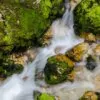Issue 4/2024, Science
Aquatic publication review (12)
We begin with the ever-heating topic of Nature Restoration Law and an analysis of the main challenges Europe will have to face in order to implement the demand to restore free-flowing rivers. To rehabilitate rivers, you need the right tools to manage the waters. This is where remote sensing techniques and geospatial analysis come to the rescue, providing invaluable support for prioritizing activities. One of the most important conditions for the success of work directed at protecting and restoring the Earth’s resources is a positive public attitude. And with this it varies, as evidenced by the results of a study of citizens’ attitudes to climate change in 63 countries around the world. Our diet is not insignificant to the earth’s resources either, and one measure of the impact on them can be the health-environmental performance index. His analysis along the gradient of the socio-demographic index leads to interesting conclusions. And finally, about how water saves lives even in very non-obvious ways, i.e. how rain increases the chance of survival after being struck by lightning.
1. Seven challenges in the implementation of the Nature Restoration Law to restore free-flowing rivers
Stoffers T., Altermatt F., Baldan D. et al. (2024). Reviving Europe’s rivers: Seven challenges in the implementation of the Nature Restoration Law to restore free-flowing rivers. WIREs Water, e1717.
The uproar over the EU’s NRL Nature Restoration Act (NRL. Nature Restoration Law ) hasn’t gone quiet, and it’s hardly surprising, since the act is not only an incredible opportunity to restore (or at least improve) the environment, but it’s also a huge challenge, and the difficulties associated with its implementation could realistically jeopardize its success or lower its ambitions. One of the goals of the NRL (Article 7) is to restore river ecosystems in order to increase the share of the so-called “riverine ecosystems. Free-flowing rivers, including restoration by 2030. communications and functions for 25,000. km of currently transformed watercourses. What are the challenges involved? An attempt to answer this question was made by researchers from several European centers in an issue paper published in Wiley Interdisciplinary Reviews – Water. The authors formulated and discussed seven major challenges to achieving this goal, including: the need for clear definitions of the concepts of rivers, free-flowing rivers, barriers and reference areas (currently, depending on the criteria adopted, the estimated total length of rivers in Europe varies from about 600,000 to more than 1.6 million kilometers), proper recognition of the structure of the river network and the state of its connectivity, the inclusion of a meta-ecosystem approach in restoration planning, or increasing awareness and involvement of citizens and stakeholder participation in the process. The challenges outlined in the article are particularly important for rivers, but also have implications for other ecosystems and may be useful for policymakers, conservationists and others involved in the Restoration Act and related policy initiatives.
2. From pixels to riverscapes: how remote sensing and geospatial tools can prioritize riverscape restoration at multiple scales
Glassic H.C., McGwire K.C., Macfarlane W.W. (2024). From pixels to riverscapes: How remote sensing and geospatial tools can prioritize riverscape restoration at multiple scales. WIREs Water, e1716.
Now that we know that we can’t escape from river restoration (whether we like it or not), the question of how to do it wisely so that the measures taken are effective and efficient must be answered. Priority setting may be misplaced if decision-makers rely only on monitoring data collected at the river scale, without considering the catchment and landscape context. And this is where remote sensing techniques and geospatial data analysis tools come to the rescue. In a comprehensive review paper published in WIRES Water, researchers from centers in Montana, Nevada and Utah are looking at how remote sensing and geospatial data can be used to assess the condition and extent of river networks in large landscape units, to evaluate their conditions, to estimate climate resilience, and to develop a conceptual framework for prioritizing river conservation and restoration efforts based on the river landscape concept. The authors introduce the concept of riverscape (riverscape) to describe a planning unit that extends beyond the riverbed, including flood plains and a network of associated watercourses. The proposed approach is based on an analysis of the topography of the valley bottom (using the Valley Bottom Extraction Tool (VBET), the condition and abundance of riparian vegetation (the NDVI index, determined from imaging information from Landsat Thematic Mapper and Sentinel-2 satellites), and the location and extent of the lowest areas of the valley bottom that are most likely to exhibit lateral connectivity during flooding.
The application of these procedures and their results are presented by the authors using the example of the catchment areas of three rivers flowing in Nevada and California. As they point out, some river restoration projects in the United States have failed because they covered too small an area to restore the health of the river landscape and associated ecosystem processes. The proposed approach with river landscape units and the use of remote sensing and geospatial data can potentially improve the efficiency, effectiveness and scale of river landscape restoration activities, leading to better ecosystem conservation outcomes.
The use of remote sensing and geospatial techniques in the analysis of aquatic ecosystems is also being developed in our country (as we have written about in previous reviews) and is definitely guiding the development of the methodological workshop in water management.
3. health-environment efficiency of diets shows nonlinear trends over 1990-2011
He P., Liu Z., Baiocchi G. et al. (2024). Health-environment efficiency of diets shows nonlinear trends over 1990-2011. Nat Food.
Food production is one of the industries that has a very strong impact on the environment, but this impact depends largely on how people eat, as well as their consumer choices. Food supply inevitably involves the use of non-renewable natural resources and generates pollution. What is needed, therefore, is knowledge of how these limited environmental resources can be used effectively to generate measurable health benefits. Changing global dietary patterns to improve population health, but also reducing the harmful environmental impacts of food production, are becoming an increasingly important issue on global and national policy agendas. In a paper published in February this year in Nature Food researchers are looking at how diets in different countries support healthy living at the expense of environmental pollution and resource consumption in four key aspects, viz. greenhouse gas emissions, water abstraction, acidifying and eutrophic emissions. They based their analysis on a health-environmental efficiency index, defined as the ratio of health benefits to environmental impacts from food production and consumption, using data from 195 countries over the period 1990-2011.
It turns out that the value of the health-environmental efficiency index along the gradient of the socio-demographic index (the geometric mean of normalized per capita income, education level and fertility rate, SDI) runs non-linearly and takes the shape of the letter N. This means that efficiency first increases (for example. thanks to the elimination of child and maternal malnutrition through better food supply in countries with low SDI), then decreases as a result of additional environmental impacts (resulting from the shift to animal products as the population’s wealth increases), and then shows a slow increase again in some developed countries as people shift to healthier diets. The report confirms a truth that is probably no longer new: what we eat matters for the environment, but it also depends on the wealth of the society in which we live, with the greatest negative impact coming from societies that are on the decline.
4 Addressing climate change with behavioral science: A global intervention tournament in 63 countries
Vlasceanu M., Doell K.C., Bak-Coleman J.B. et al. Addressing climate change with behavioral science: A global intervention tournament in 63 countries. Sci. Adv. 10, eadj5778(2024).
Since this is the case, as the previous work indicates, the question is how ready societies are to change their behavior in the name of environmental protection. We have research for that too! It examined which strategies, designed to support sustainable actions, most motivate people to change their beliefs and patterns of behavior. A team of more than 250 researchers conducted a survey of nearly 60,000. people from 63 countries on 11 behavioral interventions affecting four areas: (i) belief in climate change, (ii) Support for climate change mitigation policies, (iii) willingness to share mitigation information on social media, and (iv) Willingness to make a voluntary effort to support environmentally friendly activities (here, tree planting), or what is known as “tree planting. WEPT procedure – Work for Environmental Protection Task. The effectiveness of the interventions was generally low, largely limited to climate change believers, and varied strongly depending on the factor analyzed. People’s initial beliefs about climate change were also not uninfluenced (it is well known that the most easily convinced are the most convinced). These results suggest that the impact of behavioral climate interventions varies by target audience and behavior. It is interesting that it took such extensive research to establish this fact, but the article shows in detail the components of this phenomenon. Several centers from Poland participated in the study, so one can trace how the issues of attitudes to climate change are shaping up in our backyard.
5. rain may improve survival from direct lightning strikes to the human head
Machts R., Hunold A., Drebenstedt C. et al. (2024). Rain may improve survival from direct lightning strikes to the human head. Sci Rep 14, 1695
And finally, a somewhat humorous, perhaps, but actually deadly serious thread on how rain can increase our chances of survival after being struck by lightning. There is evidence that humans can survive a direct lightning strike to the head. But a team of biomedical scientists and physicists from the Technical University of Ilmenau in Germany asked whether rain accompanying thunderstorms contributes to increasing or decreasing the chances of surviving such an event. Using a realistic phantom of a human head, they measured the effect of the presence or absence of water on the effects of a high-energy lightning strike. The number of perforations and scarred areas near the points of lightning strike was lower and the amplitudes of the brain current were lower on the wet head phantom than on the dry one. Based on this, the authors conclude that rain on the scalp could potentially yield a survival rate of 70-90 percent, primarily due to less exposure of the brain to current and less mechanical and thermal damage. Nonetheless, we do not recommend testing this on your own skin.

 Polski
Polski







